You must visit Petra in Jordan. This ancient city in the desert, with its pink rock and facades of temples built into the rock face, a theatre and tombs, is a city lost in time.
Sitting there, I could imagine ornate Corinthian columns standing straight and tall, the 3-metre-high marble altar glowing in the sun, people wandering around the shops, then sitting to rest and chat by the pool in the shade of the garden. It is easy to imagine history coming to life in this ancient, UNESCO-listed wonder of the world.
I loved going to Petra, despite my husband and I coming back limping and bloody, we still enjoyed ourselves. Hopefully, with the tips below, you will have an enjoyable trip and return unscathed.
What you will see
The Visitor’s Centre
At the entrance is the visitor centre, where you get your tickets. There are also toilets, food and tourist shops. There are also stepped seating under a shelter, which is very welcoming afterwards. We found it a nice place to sit and eat ice cream while recovering.
From here, you have a choice of walking, taking a horse, or an electric car (more details to follow).
The Path to the Siq
You begin with a path that leads to the Siq (a narrow gorge). The path descends slightly, then rises, and takes 10 to 15 minutes to walk. You must listen out for the electric cars and get out of their way. When we went, they also had horses and carriages, which got dangerously close to the walkers. The drivers had the attitude that if the tourists didn’t get out of the way, it was their fault. I closed my eyes several times on the day we took a horse and carriage, as I thought our driver was going to hit someone; if they had moved only an inch to the left, they would have been hit. I don’t know if the electric car drivers will be any better, but I presume many of the drivers will be the same people.
As you walk down the path, you soon see three huge sun blocks on the right, approximately 7 metres tall, guarding the city’s water supply.
The Siq
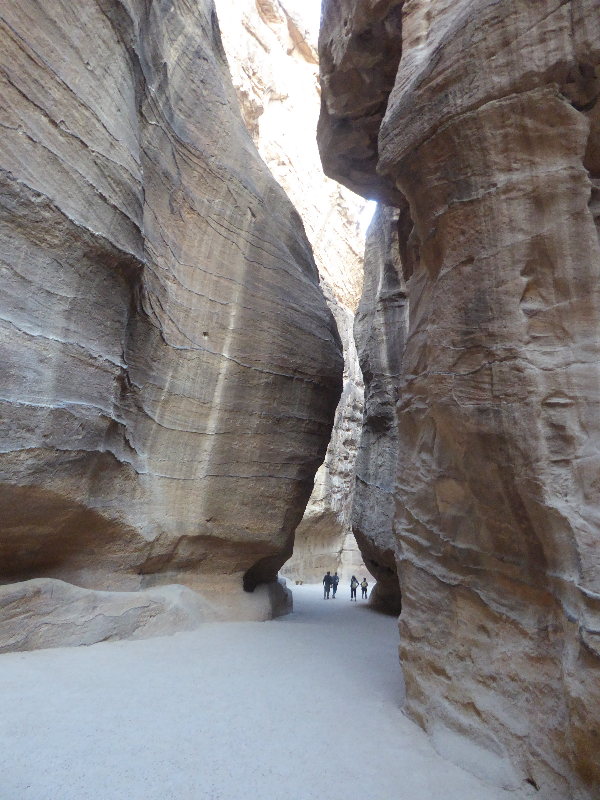
You then come to the Siq, which is ¾ of a mile long (1.2 km). Its walls are over 650 feet high (200 metres) and twist and turn. The gap narrows to 10 feet (3 metres) wide at some points. This passageway was formed by a split in the land due to plate tectonics, not by a river, so I am not sure if you can technically call it a gorge. It is interesting to see how the different strata in the rock change colour and direction.
At the start, there is a dam which was built to protect the city from flooding; this was renovated in 1964. There are ancient water channels beside the path in places and niches in the pretty walls. The highlight for me was when I spotted the Treasury through the gap at the end of the Siq. I could imagine what it is like to discover this place for the first time before its photograph spread around the world. Even though I knew what it looked like, it was still an amazing sight to see.
The Treasury
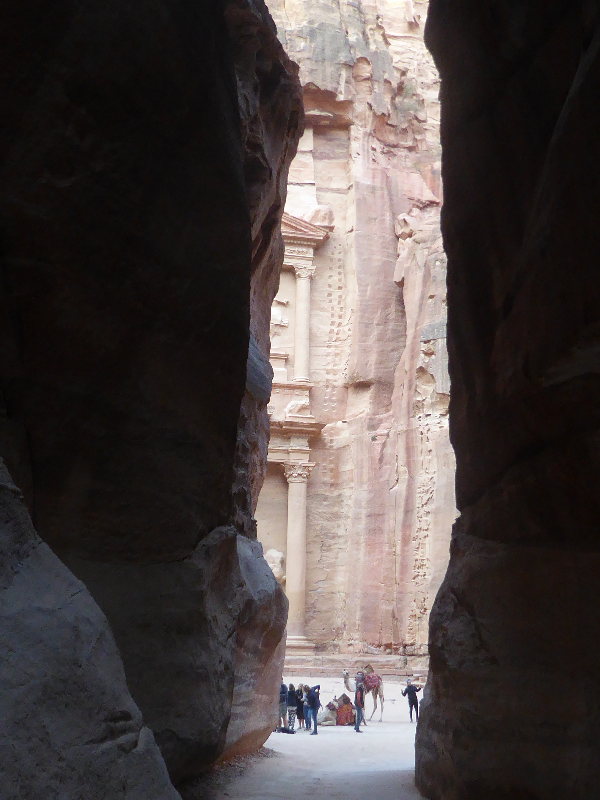
This Treasury is 131 feet high (40 metres) and is very impressive. When they carved these buildings, they began at the top and worked their way downwards.
The Treasury has two large eagles at the top as a symbol of the god Dushara. In the centre below the urn is Isis (an Egyptian goddess). At ground level, the mounted riders are Castor and Pollux, sons of Zeus. You can’t go into the Treasury, but there is an unusual round window inside, and a recessed basin in the interior, which was probably used for ritual washing.
The Street of Facades
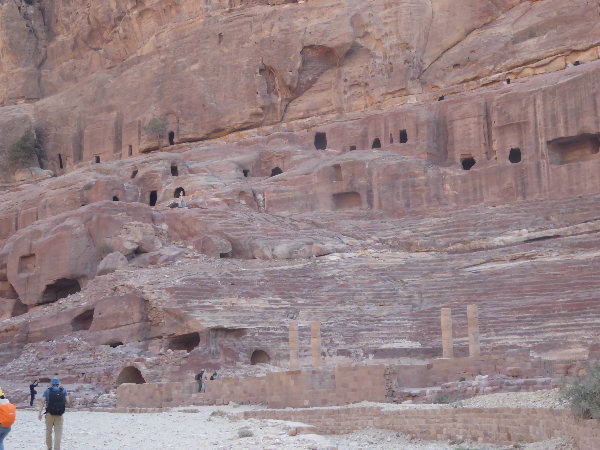
As you follow the route, the valley widens and you can see various buildings carved into the rocks. There are more than 40 tombs and houses here, some of which are at ground level, while others are located higher up. Unless you are an expert or have a guide with you, there is little to see except carved-out holes for windows and doors. It was interesting to see how low one door was. This was due to the floor rising because of deposits after flooding, not because the door was made low.
The Theatre
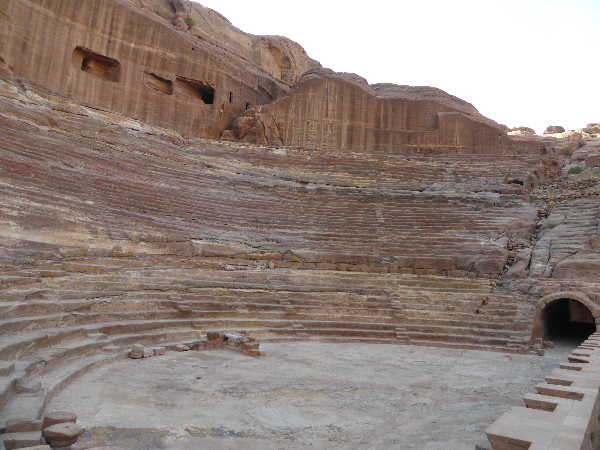
The theatre is on the left and worth a visit, but you can’t go down onto the stage, which is a shame, as it is only from this angle that you can imagine what it was like. However, as it is over 2000 years old and has been damaged by an earthquake, they don’t need tourists trampling all over it. I did notice it was near a valley side, and it was in the shade when we saw it. I did wonder if they had their performances when the valley provided shade from the sun.
The Main High Street
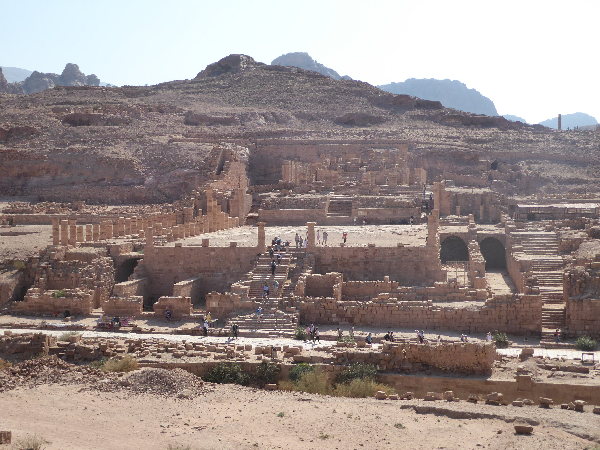
There is plenty to see and explore in this area. There is the Nymphaeum, a Roman public fountain, the ruins of old shops, and an area that was once a garden. Behind the garden, there used to be a pool 140 feet x 75 feet (43 x 23 m). Columns surrounded the pool, and in the middle of the pool was a small island with a rectangular pavilion. Standing in the hot desert sun, it is easy to imagine how beautiful this must have looked.
There are also temples to visit here, the Great Temple and the Temple of Dushares, although the Great Temple might not have been a temple at all. It was used as a gathering place, a council chamber and had a theatre at the back. The legend of the Temple of Dushares is that it was built to safeguard his daughter. At the time I visited, this building was off-limits.
At the end of the street, you can walk to the monastery (As-deir). If you turn around to face the street, on the left are the Winged Lion Temple, the Blue Chapel, and the Byzantine church.
The Winged Lion Temple, Blue Chapel and Byzantine Church
You might be tempted to miss these attractions if you have limited time. However, the mosaic at the Byzantine church shouldn’t be missed. The church was burnt down and destroyed by earthquakes, but now it is under a cover and the mosaic has been restored. Most of the mosaics depict animals, but one resembles an ice cream sundae in a tall glass.
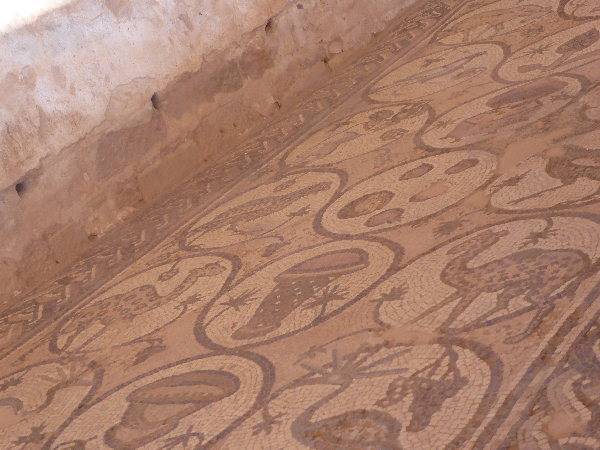
In this area, the only café we visited had a limited selection of drinks and may have offered some snacks or food, but I don’t recall. It was, however, very pleasant sitting outside in the cool breeze on soft padded seats with a shaded cover over us and a lovely cool drink in our hands.
The Royal Tombs
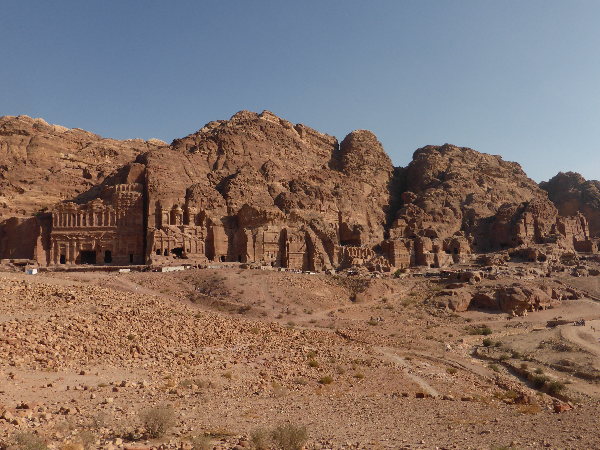
If you are at the far end of the main street facing towards the entrance, you can see the royal tombs beyond the Byzantine Church. We walked from the church to the tombs, but you can turn right before reaching the main street, when walking away from the main entrance. Accessing the Royal Tombs may be challenging for individuals with mobility issues or those who are elderly, as the site features large, uneven steps.
The tombs are big, empty chambers, and some didn’t smell very nice. I think animals were kept in there at night. However, they do look imposing from the outside.
There is the Palace Tomb, the Corinthian Tomb, the Silk Tomb, and the Urn Tomb. The Palace Tomb is five stories high, and the Urn Tomb may have been used as a court at some point. If you look at the back of the Urn tomb, in the left-hand corner, there is a Greek inscription dedicating the church by Bishop Jason in 447 AD.
Trails
Eight trails lead to different sights to see. These trails range from 0.6 miles to 7.4 miles (including return) and from ¾ hours to 7 hours. Two walks are very popular, the walk to the monastery (As-deir) and the Al Khubtha trail, which leads to views down to the Treasury.
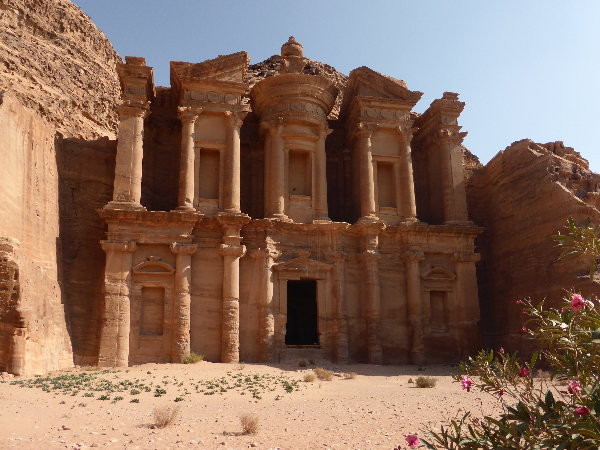
The walk to the monastery (As-deir) is listed as 1.5 miles (including the return journey) and takes 2 ½ to 3 hours, and is listed as hard. For the average person, the walk is fine. There are 800 steps up, and at times it was a bit confusing for us to know which path to take, but this was only because we were the only people doing this walk early in the morning. Later in the day, you follow the crowd. The path to the monastery begins on the far side of the café, located at the end of the main street.
I would suggest using the toilets near the café, as I didn’t see any on the walk to the monastery. However, I have been told that there was a not-too-clean toilet when someone took this walk some time ago.
There are stalls along the path in some areas, and a place to buy drinks and snacks is available at the top, along with comfortable seating.
The monastery walk had no nasty drops beside it, only the occasional drop of a few feet.
The walk to Al Khubtha is a 2-mile round trip and takes 2-2 ½ hours. It is listed as hard, but it is essentially a series of steps walking uphill. There are some points of the walk with drops down the side. Although the path is safe, the long drops might be uncomfortable for people who don’t like heights. The steps are a bit worn away in places, but still doable. Just be careful when you get to the top, as there are no real barriers. At the end of this path, you get to see the Treasury from above. Although it is an interesting angle, I prefer the photos from ground level, so if you can’t manage this walk, you don’t need to feel you missed out on a brilliant photo opportunity.
How far & what are the paths are like?
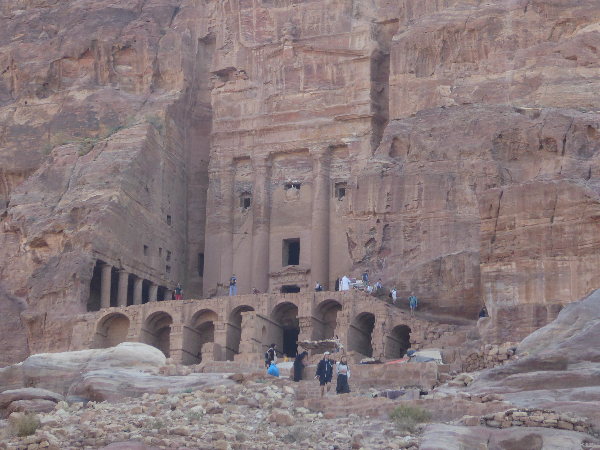
The walk from the visitor centre to the end of the high street is listed as 2.7 miles. This can take much longer than you think, as there is a great deal to see. The walk starts off going down a bit, then up again, after which it is mostly flat or declines very gradually, unless you take one of the side walks.
On our first day, we started at 6:00 a.m. and returned at 5:15 pm. The trip included a walk to the monastery (As-deir). You can therefore see all the main attractions in one day. However, you need to start early. If you want to do more than one of the shorter trails, you will need more days.
The paths are flattened mud with the occasional rock or stone on them. I was wearing trainers and managed to twist my ankle on a path. To get to the royal tombs or go on a trail, you will have to climb steps made out of rocks. Some of the trails away from the central area have drops alongside them, so research beforehand if you don’t like heights.
Toilets and shops.
There are plenty of toilets located at the beginning and end of the main path, as well as at several points along the route. The toilets aren’t brilliant but are acceptable. There are numerous places to eat and drink along the way. The Crowne Plaza, located at the end of Main Street, is where most tour parties typically dine. It is a little pricy and gets mixed reviews. There are stalls scattered throughout the area, offering a variety of choices for souvenirs.
Petra by Night
From Sundays to Thursdays, there is a show at the Treasury. At 8:30 pm, they open the gates, allowing you to walk from the visitor centre to the Treasury. At the treasury, you sit on mats, listen to the music and drink tea. Thousands of candles light up the path leading up to the Treasury and in front of it. There are also changing coloured lights on the Treasury. Then the music started, and a poem was read. At the end, you all walk back again. The event finishes at 10:30 pm.
There are mixed reviews of Petra by night. Some people arrive very early so they can be among the first to walk to the Treasury and sit at the front when the gate opens. They all walk as fast as they can so they can be at the front of the Treasury. This isn’t a perfect plan, as often those who arrive very late are told to sit or stand at the front, or sometimes there are people already there before everyone else.
The magic of the place is walking in candlelight, so the walk should be enjoyed, creating the excitement of arriving at a lit-up Treasury. The path is dark in places, with loose stones, jutting rocks, and an uneven surface. Some people bring torches, but then some of the magic is lost.
You are directed where to sit, and then have to wait until everyone has arrived. The choice of music wasn’t to most people’s taste, and many struggled to hear the story being read. The bright lights on a nearby shop were also distracting. However, this year (2025), they say they have improved the show with “projection mapping and immersive narration”. After an hour, provided your legs cope with sitting on a mat, you then walk back with the large crowd of people.
Tips for Visiting Petra
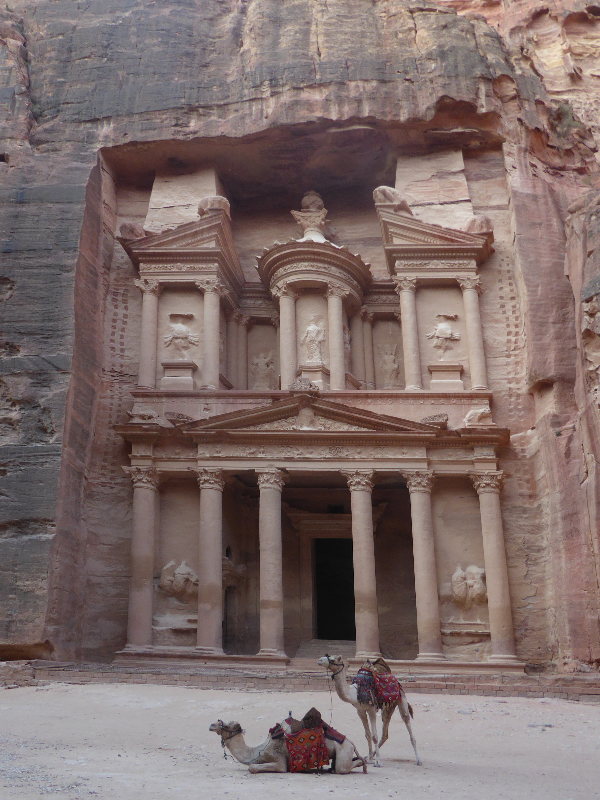
- Get there early. On the first day, we got there at 6 am, and the place was amazing. Exploring, taking photos without people getting in the way, and experiencing what the place is like, is best without the crowds. The next day, we arrived at 9:30 am, and it was crowded. You could easily miss the camels in front of the treasury because of the crowds; there was no way to get them in the photo with the treasury. There were also numerous stalls, which weren’t set up early in the morning, so they weren’t intrusive during our 6 o’clock start. However, by 9:30, the surroundings became lost in the bustle of people and stalls.
- Take a passport and small coins/ notes. You will need to present your passport when purchasing a ticket. Tickets are more expensive if you visit on your first day in the country, so you need to show your passport to prove when you arrived. You need small coins and small notes because you are unlikely to get any change if you only have large notes.
- Take water, sun cream and a sunhat.
- Take the club car (electric vehicle) if you have mobility issues or difficulty walking long distances. Walking in the heat can be tiring; there aren’t many comfortable places to sit, except for the odd wall or steps, unless you stop at a cafe. Save your energy and start exploring at the Treasury. The most tiring bit of the day is the walk back from the Treasury; it seems much further than the journey out.
- Food and drink can be expensive in Petra, and sitting down for a proper meal can take ages. We took our own food and had a lovely breakfast picnic up by the monastery with stunning views and away from other people.
- If you are going on one of the trails, you might want to avoid the hottest time of day, which is 12 to 3 pm. If you are doing a popular trail, such as the monastery, going early means you won’t have to walk slowly behind people who struggle with the steps or feel rushed up the steps because of a crowd behind you.
- Although I recommend arriving early, please note that the Treasury is exposed to direct sunlight from 9:00 to 11:00 a.m. and from 5:00 to 6:00 p.m. At other times, a shadow might be cast across the Treasury.
- The stallholders here have significantly inflated prices, so you can haggle hard or buy your items away from Petra. If you are walking to the monastery, don’t tell the stall holders, “you will think about it”, or when you walk back down, they will expect you to buy something. Some sellers are aggressive and persistent, just repeating “no thank you” should be sufficient.
- Don’t buy things from the children. A lovely young girl tried to sell us rocks she had picked up from the site. This is not allowed, and besides, if you buy from children, you are encouraging them to miss school.
- At the time of writing, horse carriages had only just been replaced with electric carts. As far as I know, they still have horses and donkeys. The animals at Petra have not been treated well, and despite consulting a veterinarian, it was still felt necessary to replace the horses and carriages. If anyone offers you a donkey ride, I would decline it. Not only for the animal’s sake, but also because of the stories I have heard about saddles being so loose the rider nearly fell off, or the donkeys getting very close to the edge of the path. People who have taken donkey rides have found they are told to get off before they arrive at the top, or they can’t get up faster, as claimed, because the path is too busy. You can’t go far on the horses, although they say they are included in the price of the ticket; in reality, you have to pay a large tip.
- If you are a woman, don’t accept an invitation for a free tour, especially if you are on your own. The man might expect payment sexually.
- If you are going to Petra at night, get there early, just after 8:00. It is much better at the treasury before the crowds arrive. You don’t have to stay seated on the mats; you can move around the edge, which might be better for photography. Get your ticket before the night; you can buy tickets from hotels or the shops at the visitors’ centre. You may need cash to purchase this ticket, as the Petra Authority does not operate it. You are supposed to have a day ticket if you attend the night event, but no one seems to check.
- Check for the latest information at https://www.visitpetra.jo/en
Warning
Be cautious when climbing, especially if you leave the main paths, such as when climbing the rocky walls around the Treasury to reach an elevated vantage point. These areas should be avoided, as people have been injured or, in some cases, died while attempting to access them. We scrambled up to take some photos, and my husband slipped on some loose rocks on the way back down. I was holding onto his rucksack, which stopped him sliding down the 25-foot slope, leaving us both with just a few cuts and bruises. Since our visit, they now offer a cliff view ticket, so I hope that means they provide a safer way to view the treasury from a higher vantage point. The ticket costs 10 dinars and is available for sale near the gorge entrance.
Another thing to be wary of is flooding. In 2018, 12 tourists were killed due to a flash flood. This is a rare event and should only concern you if it has been raining heavily. However, some people do take routes they have been advised against due to flash floods. Those people need to realise flash floods can be serious.
Keep out of the way of the electric cars. As mentioned earlier, drivers aren’t always that careful. People have reported being hit in the Siq and the path to it.
Tickets
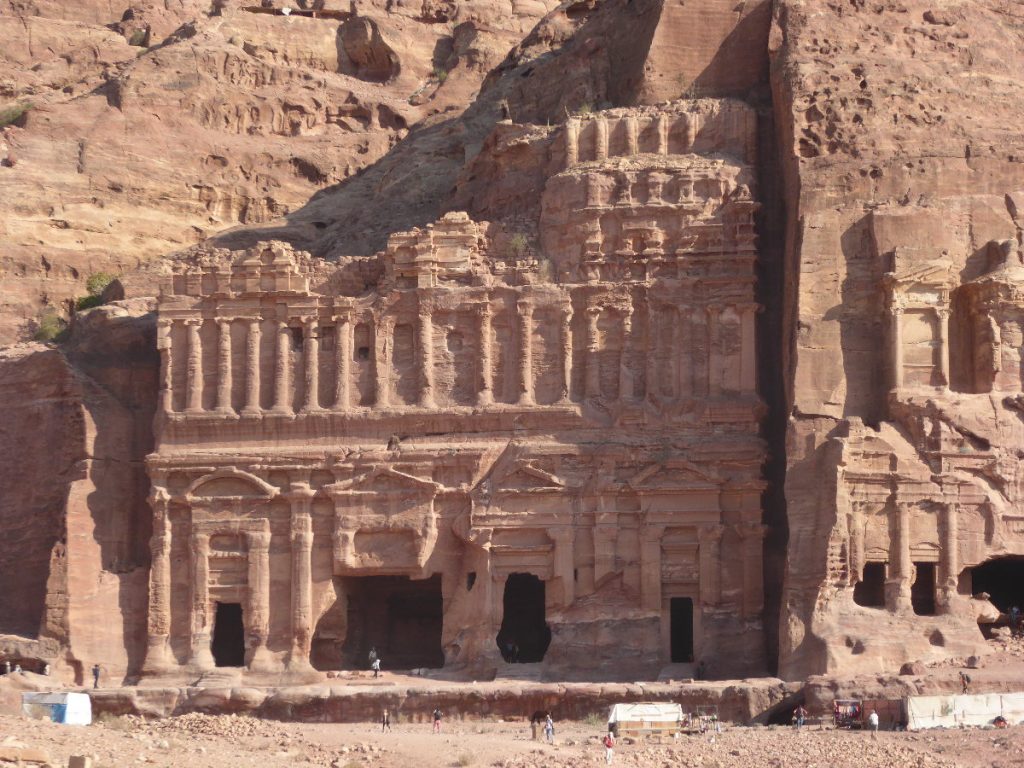
1 day = 50 JD
2 Days = 55 JD
3 Days = 60 JD
If you visit Jordan for just one day, e.g. on a cruise = 90 JD
If you visit on your first day of arriving in Jordan, then you pay 90 JD, but if you return on the second day, you can get a refund of 40 JD
Children under 12 are free.
They accept credit cards or cash.
Don’t forget to take your passport
Jordan Pass can be used here.
Petra at night costs 30 JD and you can’t use a Jordan pass, free for under 10-year-olds
Opening times
Summer (March – September) 6 am – 6 pm
Winter (October – February) 6:30 am – 5 pm
Note: Club cars are not available until 7 am.
Petra Museum
The museum is free and is right next to the entrance to the Petra visitors’ centre. It is open 8:30 to 7:30 except on Tuesdays, when it closes at 12:30
The museum is not very big. We did it after a full day of exploring Petra and were too tired to do the museum justice. We had car trouble; otherwise, we would have gone the day before we explored Petra. This way, we would learn more before our visit.
How to get to Petra
From Amman airport, it’s a 3-hour drive.
A cheaper option is to get a taxi to the bus station, then take a bus from there. However, there is a very limited choice of buses, and they can take much longer.
From Aqaba airport, the car journey is 2 hours.
There are free car parks near the entrance to the Visitors Centre. It’s best to refer to Google Maps to locate them as they are not signposted. We used the closest car park. If you drive towards the Visitors Centre, you will see a road on the left just before the centre, where you can see a barrier across the road. Head towards the barrier and then take the road on the left.
Driving in Jordan isn’t too bad, but you need to be alert at all times, as some of the local drivers do things you never expect, such as while a car is overtaking another vehicle, a third car will overtake both cars on a single lane road. Some people hire drivers, and if you are not a confident driver, this can be a good option.
Where to stay
There are plenty of hotel choices to suit various budgets, but if you have a particular hotel in mind, it’s recommended to make reservations months in advance.
The Mövenpick Hotel is conveniently located near the entrance, and the majority of reviews are positive. This hotel is part of a worldwide chain. Even if you are not staying here, you should try the ice-cream parlour. When I tried to book here even 6 months in advance, I was quoted £2000 for a 3-night stay for three people. For two people, it was more reasonable at about £140 per night.
We stayed at the Quattro Relax Hotel, which is located over a mile from the visitor centre and takes approximately 5 minutes to drive to by car. I have never been to a hotel where the manager has been as helpful as this one. We were having problems with our car tyres, and he advised us where to go. We couldn’t figure out how the machine worked, and when we returned to the hotel, the manager asked how we got on. He then got in our car and went to the garage, where he pumped up the tyres for us. This hotel is half the price of the Movenpick hotel and is clean and tidy. Its location is not as good, but the customer service more than makes up for that.
Petra Guest House Hotel is right on the doorstep of the Visitor’s Centre. It costs around £110 per night and has a cave bar. It generally gets good reviews.
Note that many hotels that aren’t within walking distance offer a shuttle, so you don’t need to limit your choice if you don’t have your own transportation.
When to go
Summer can be very hot in Petra. The average temperature is 25.2°C (77.4°F); however, it can reach as high as 33°C (91.4°F), and there is very little shade. In winter, it can rain, which may cause flooding—the average temperature is 7.8°C (46.1°F). However, winter is a quiet period, and hotel prices can be more affordable. The best times, therefore, are spring (March to May) or autumn (September to November). We went in November and found the weather very pleasant, warm enough to go into the sea in Jordan but not too hot.
Generally speaking, most tourists are not affected by public holidays. Petra will remain open, and transportation services will continue to operate. The banks, however, will be closed. On Eid al-Fitr and Eid al-Adha, you may find more shops closed, as these are important days of celebration. During Ramadan you may find buying alcohol a bit more difficult. You should also not eat, drink or smoke in public during Ramadan as it will be frowned upon.
Summary
If you’re interested in history, seeing Petra will be a fantastic experience. I was surprised at how big it was, considering it was in such a barren area. I watched a couple of YouTube videos before visiting, which helped me appreciate what I was seeing and brought the place alive.
I enjoyed seeing Jordan, the Dead Sea and the Wadi Rum desert. If, however, you don’t want to spend too much time in Jordan, there are plenty of cruises that stop in Jordan and visit Petra.
Petra has been listed as one of the New Seven Wonders of the World. If you haven’t been, you should put it on your list. It is a fascinating place, showing a glimpse into a world that is long gone.
Have a lovely trip, and don’t come back limping and bleeding like we did. I’m sure you are more sensible and will stick to the proper paths.
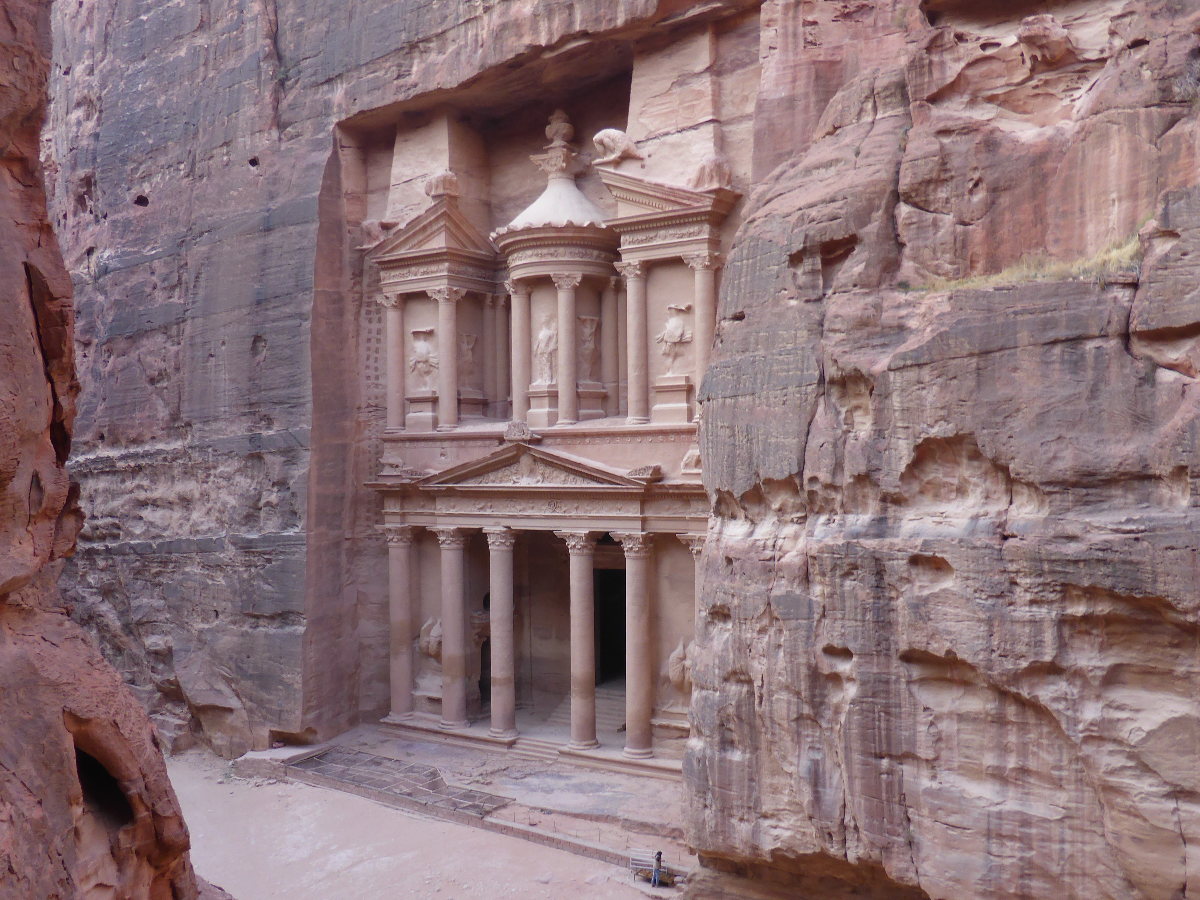
Leave a Reply